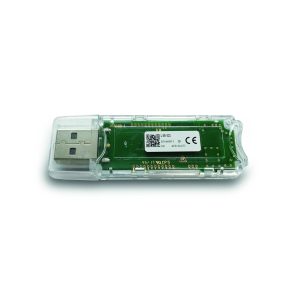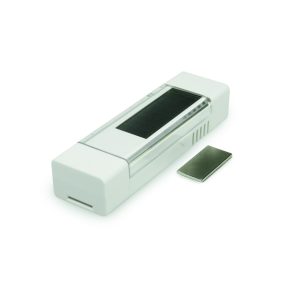EnOcean radio standard
The EnOcean radio standard holds international standardization under ISO/IEC 14543-3-10, allowing for universal usage akin to Wi-Fi or Bluetooth.
It’s specifically tailored for wireless solutions with exceptionally low energy consumption, utilising energy harvesting. The minimum telegram length sent is approximately one millisecond, with a data rate of 125 kbit/s. These telegrams are repeated multiple times within a 40-millisecond timeframe.
As they’re dispatched at irregular intervals, clashes between end telegrams are averted, allowing for seamless operation of multiple switches and sensors concurrently. Every EnOcean radio module is equipped with a 32-bit identification number, guaranteeing dependable transmission. The radio signal spans up to 300 metres in open areas and approximately 30 metres within buildings.
The standard operates on the 868 MHz frequency band in Europe, 902 MHz in North America, and 928 MHz in Japan. These radio waves effectively penetrate walls and provide strong transmission power. Simultaneously, the high-frequency radiation is significantly lower—100 times less than in traditional wired solutions.
As advocates of this standard, the EnOcean Alliance presents an interoperable ecosystem comprising over 1,500 devices from 400 members, all built on the open EnOcean wireless standard. This interoperable EnOcean wireless technology facilitates swift and effortless installation of cutting-edge sensors, switches, and other devices powered by energy harvesting, using a “peel and stick” approach.

About EnOcean 868MHz
EnOcean 868MHz serves as a leading wireless communication standard predominantly utilised across Europe. Operating within the 868 MHz frequency band, it finds extensive application in building automation, smart homes, and industrial settings. Renowned for its minimal power consumption and energy efficiency, the EnOcean 868MHz protocol is particularly suited for battery-less or energy-harvesting devices.
Devices adopting the EnOcean 868MHz standard facilitate wireless communication over considerable distances, even traversing walls with ease due to the radio waves’ adeptness at penetrating obstacles. This capability renders it apt for scenarios where dependable communication is paramount, yet traditional wiring proves impractical or cost-intensive.
The EnOcean Alliance, acting as an advocate for this standard, has curated an ecosystem of interoperable devices sourced from diverse manufacturers. This fosters seamless integration and compatibility among various products, encompassing sensors, switches, actuators, and controllers. Consequently, it enables the creation of comprehensive and adaptable wireless automation solutions.
In essence, EnOcean 868MHz technology presents a dependable, energy-efficient, and versatile wireless communication solution catering to a broad spectrum of applications within the European market.
EnOcean Wireless Standard
The EnOcean ecosystem provides buildings with flexibility, energy savings, and cost-effectiveness.
- High Reliability
- Interoperability
- Low Energy Requirements

The compatibility among various end-products plays a crucial role in the success of introducing self-powered sensor solutions to the market.
That’s why the EnOcean Alliance focuses on standardizing communication profiles (EnOcean Equipment Profiles – EEPs), guaranteeing that sensors from different manufacturers can communicate with receiver gateways from other brands. This approach provides end-users with access to a wide range of self-powered wireless switches, sensors, and controls within the entire product portfolio.
ENOCEAN WIRELESS STANDARD OPTIMIZED FOR SELF-POWERED WIRELESS DEVICES
The EnOcean wireless standard is designed for wireless sensors and sensor networks with extremely low power consumption. It encompasses sensor networks that leverage energy harvesting technology to extract energy from their environment, such as motion, light, or temperature variations.
This approach allows for the deployment of electronic control systems that operate autonomously, without relying on an external power source. The EnOcean wireless standard (ISO/IEC 14543-3-1X) in the sub-1GHz range is tailored for building applications, offering a radio range of up to 30m indoors.


Europe and China

North America

Japan
Benefits of using the EnOcean wireless standard
High Reliability
The frequency bands of 868 MHz, 902 MHz, and 928 MHz are license-free, offering a 1% duty cycle and providing a dependable radio range of approximately 30m indoors.
Interoperability
Sensor profiles undergo standardization to ensure seamless interoperability across all product manufacturers and to deliver compatible system solutions.
Low Energy Requirements
Designed for self-powered switches and sensors, with a fast data transmission rate of 125 kbit/s for sensor data.
EnOcean 868MHz product
EnOcean Middleware
EnOcean offers OEMs the EnOcean Link middleware for energy-harvesting wireless technology. With this licensed software, OEMs can seamlessly integrate EnOcean technology into various applications and systems, including those in more efficiently and swiftly.
The software presents a universal interface for wireless communication and automatically decodes information from EnOcean telegrams. Consequently, sensor data like humidity or temperature is automatically organized, enabling different devices, servers, and even cloud services to promptly process it.
The middleware automatically considers all specifications of the EnOcean protocol stack, available frequencies, and the EnOcean Alliance’s EEP, along with encryption mechanisms. By interpreting all data, the software guarantees interoperability among equipment from various manufacturers.
Rather than creating their software to interpret the communication protocol of energy-harvesting wireless technology for a specific application, OEMs can readily utilize the pre-built middleware. EnOcean Link is suitable for receiver and gateway solutions and any application incorporating or processing energy-harvesting wireless radio technology.
Endless Energy
Operating without batteries, a device gains a compelling unique selling point to secure a robust market position. The well-proven and established technology serves as a dependable alternative to batteries and wires, imparting an eco-friendly, maintenance-free quality to the device.
EnOcean’s energy-harvesting wireless technology adopts a platform approach, ensuring manufacturers face minimal integration challenges. They have access to all necessary components, already optimally aligned with each other. This simplifies the transition from battery or wire power to energy harvesting.
Advanced Security Mechanisms
All EnOcean modules have a unique 32-bit identification number (ID), which cannot be changed or copied and therefore protects against duplication. This authentication method already offers field-proven secure and reliable communication in building automation.
- Development Platform
- Development Tools

For applications requesting additional data security, a security mode protects battery-less wireless communication with enhanced security measures. These include a maximum 24-bit rolling code (RC) incremented with each telegram, which calculates a maximum 32-bit cipher-based message authentication code (CMAC). The CMAC uses the AES 128 encryption algorithm. Another mechanism is the encryption of data packets by the transmitter. The data is encrypted using the AES algorithm with a 128-bit key.
The EnOcean standard 868 MHz sensor modules incorporate advanced data encryption mechanisms to meet the specific requirements of applications such as monitoring or alert sensor systems. These enhanced security measures can be optionally enabled to thwart various types of attacks, including replay, eavesdropping, or message forgery.
Out of the box, the encrypted data transmission is in standard mode, which can be activated by simply pressing the learn button for ten seconds. If necessary, the security mode can be deactivated by pressing and holding the learn button again. Additionally, a receiver capable of decoding encrypted telegrams can still handle standard telegrams, allowing OEMs to seamlessly integrate enhanced data security into their existing EnOcean-based offerings.
Development Platform
EnOcean provides support to OEMs for successful product development across various energy-harvesting wireless applications. They offer a cost-effective and tailored development platform aimed at swiftly integrating battery-less technology into building and industrial automation, as well as machine-to-machine or transportation systems.
At the heart of EnOcean’s modular developer package lies the EDK 350 developer kit, encompassing the entire product spectrum, from energy harvesting and wireless modules to pre-configured product solutions. The key component of this developer kit is the EOP 350 universal programmer board, enabling developers to configure or program EnOcean radio modules within their production environment.

Development Tools
Established development tools available for download complement the hardware portfolio, facilitating simplified product design.
The DolphinAPI serves as a software interface for programming TCM 3xx/STM 3xx modules. This API (Application Programming Interface) enables manufacturers to swiftly develop software tailored for specific applications.
The DolphinStudio suite offers a graphical user interface for configuring all necessary parameters using the API. It can also function independently for straightforward configurations and flash programming of Dolphin modules.
DolphinView, when paired with TCM 3xy/TCM 410J, provides developers with detailed insights into sub-telegram timing and signal strength. For instance, developers can analyze telegram content online and log it with a timestamp. DolphinView also supports remote management features such as ping, query, and remote learning.
Solar Energy
Numerous sensor applications harness the power of miniature solar cells. EnOcean provides a variety of modules equipped with pre-installed solar cells, including:
– STM 33x temperature sensor
– STM 33x magnet contact sensor
– STM 350 temperature & humidity sensor
– STM 550 multisensor (featuring acceleration, temperature, humidity, light, and magnet with NFC configuration)
For instance, the solar-powered STM 33x (868/902/928 MHz) sensor can accurately measure temperature in a room or on machinery. This module is renowned for its exceptionally low power consumption and high reliability. Charging for just 3.6 hours during daytime exposure to at least 200 Lux ensures continuous operation, even if transmitting a measured value every 15 minutes. Moreover, with its energy storage mechanism fully charged, the module remains functional for several days even in complete darkness.

The humidity sensor module HSM 100 extends the functionality of STM 33x temperature sensor modules. HSM 100 contains an internal calibrated humidity sensor. It can be plugged onto STM 33x modules via a 20 pin connector. The sensor signal is read via the ADIO3 input of STM 33x. In order to be able to read the sensor signal STM 33x has to be configured to an EEP supporting humidity. This can be done via Dolphin Studio.
Thermal Energy
By combining the ECT 310 DC/DC converter with a Peltier element, manufacturers can tap into thermo-electric powered applications. Temperature variations present an opportunity to harvest significant energy. For instance, raising the temperature of a drop of water by one degree Celsius (°C) yields enough energy to transmit around 10,000 EnOcean wireless telegrams. This amount of energy is ample not only for operating wireless sensors but also for powering wireless actuators like heating valve actuators.
The ECT 310 DC/DC oscillator initiates operation with an input voltage as low as 10 mV. At 20 mV or higher (equivalent to approximately 2 °C), it generates a useful output voltage of over 3 V. To achieve this impressive converter efficiency of 30% at 20mV, the output voltage is only loosely regulated to remain below 5V across the entire input voltage spectrum up to 500 mV. This regulation approach mirrors the unregulated supply voltage from solar cells. Since EnOcean wireless modules are designed for broad input voltage ranges, the ECT310 is an ideal fit for energy harvesting applications leveraging temperature differentials.



